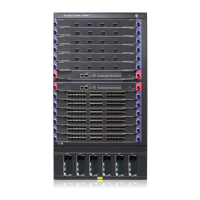268
• Configure OSPF in the LAN where CEs reside.
Configuring a loopback interface
Ste
Command
Remarks
1. Enter system view.
system-view N/A
2. Create a loopback interface
and enter loopback interface
view.
interface loopback
interface-number
N/A
3. Bind the loopback interface to
a VPN instance.
ip binding vpn-instance
vpn-instance-name
By default, an interface is
associated with no VPN instance.
4. Configure the address of the
loopback interface.
ip address ip-address { mask |
mask-length }
N/A
Redistributing the loopback interface route and OSPF routes
into BGP
Ste
Command
1. Enter system view.
system-view
2. Enter BGP view.
bgp as-number
3. Enter BGP VPN instance view.
ipv4-family vpn-instance vpn-instance-name
4. Redistribute direct routes into BGP (to redistribute
the loopback interface route into BGP).
import-route direct [ med med-value | route-policy
route-policy-name ] *
5. Redistribute OSPF VPN routes.
import-route ospf [ { process-id | all-processes }
[ allow-direct | med med-value | route-policy
route-policy-name ] * ]
Creating a sham link
Ste
Command
Remarks
1. Enter system view.
system-view N/A
2. Enter OSPF view.
ospf [ process-id | router-id
router-id | vpn-instance
vpn-instance-name ] *
N/A
3. Configure the external route
tag for imported VPN routes.
route-tag tag-value N/A
4. Enter OSPF area view.
area area-id N/A

